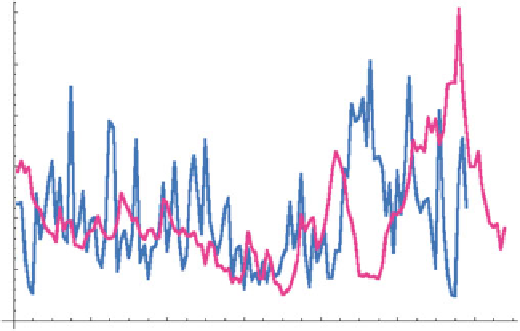Geoscience Reference
In-Depth Information
r
(x)
3
2.5
2
1.5
1
0.5
x
20
40
60
80
100
120
Fig. 12.33 Blue: original Pulacayo zinc values, with x representing horizontal distance in units of
2 m. Pink: universal multifractal simulation results for Levy index
ʱ
¼
1.8; co-dimension
C
1
¼
0.03 characterizing the “sparseness” of the mean field; and deviation from conservation
H
¼0.090. Both patterns were normalized to unity (mean ¼15.6 % Zn) (Source: Lovejoy and
Schertzer
2007
, Fig. 3a)
characterizes the deviation from conservation. A space-time universal multifractal
field for element concentration can be subject to change of its mean value in the
course of time. Even in static 3-D situations, incorporation of
H
into the model
provides increased flexibility. Lovejoy and Schertzer (
2007
) provide examples of
geophysical data for which the universal multifractal approach is applicable. This
includes applications to magnetic susceptibility data studied by Pilkington and
Todoeschuck (
1995
).
12.7.1 Pulacayo Mine Example
Figure
12.33
taken from Lovejoy and Schertzer (
2007
) shows a realistic universal
multifractal simulation for the Pulacayo orebody using the following three param-
eters: L´vy index
α
¼
1.8, codimension
C
1
¼
0.03 and deviation from conservation
H
0.090. This approach is explained in detail and illustrated by means of other
applications in a large number of publications including Lovejoy et al.(
2008
),
Lovejoy et al. (
2001
), Schertzer and Lovejoy (
1991a
), Schertzer and Lovejoy
(
1997
), Schertzer et al. (
1997
) and Lovejoy and Schertzer (
2013
). The codimension
C
1
, which characterizes sparseness of mean field, and deviation from conservation
H
can be derived as follows. First a log-log plot of the so-called “first order structure
function” (
cf
. Monin and Yaglom
1975
) is constructed (Fig.
12.34
). Successive
moments are obtained for absolute values of differences between concentration
values for points that are distance
h
apart by raising them to the powers
¼

Search WWH ::

Custom Search